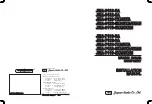
12
Signalling
Installation and Programming manual
Chapter 4
SIGNALLING
The Ivy unit provides various signals: audible, visual, activation of
the FAULT and TAMPER outputs (connectible to the intrusion-control
panel).
Each signal type can be programmed separately, combined with
other signals, or deactivated.
4-1
Types of signalling
VISUAL
SIGNALLING
The super-bright flasher uses new-generation Light Emitting Diode
technology which provides maximum visual-signal clarity with extra-
low power consumption. The flasher circuit is divided into two
groups, the left group (
Table 3, G
) and the right group (
Table 3, H
).
This type of circuitry allows you to select the options on the
Programming menus.
STATUS LED
PRG LED
The two ancillary LEDs, reveal the device status and guide you
through the programming operations (STATUS LED -
Table 3, Q
;
PRG LED -
Table 3, R
). These can be activated by the control panel
events, using SmartLeague software programme (refer to paragraph
5-3 Programming from a PC
).
These two LEDs, if suitably programmed, will signal device faults
and tamper events, for details refer to paragraph
4-2 Tamper
memory and fault signalling
.
AUDIBLE
SIGNALLING
The magneto-dynamic horn provides a choice of 4-tones, which can
be programmed with a maximum alarm time and assigned to
indicate different alarm types.
Ivy units, connected via I-BUS to the intrusion-control panel,
provide a choice of 5 tones with programmable duration and volume
options.
FAULT OUTPUT
Open-collector output with 100mA maximum current draw capacity.
During the programming phase, it is possible to select the standby
status (Normally open or Normally closed) and assign the events.
TAMPER OUTPUT
The voltage-free relay can be used to signal tamper conditions to
external devices. During the programming phase, it is possible to
select the standby status (Normally open or Normally closed) and
assign the events.







































